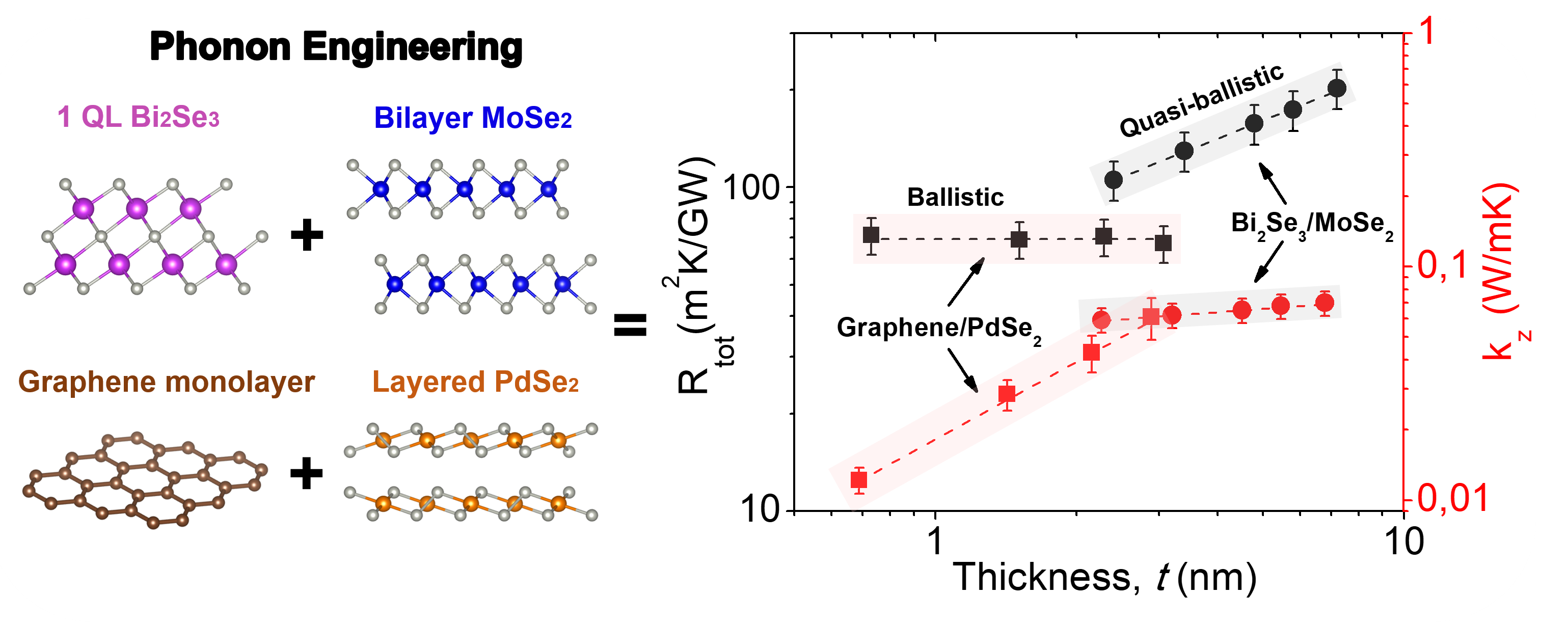Thursday, 20 July 2023
Heat, this way only: new heterogeneous multi-layer materials allow thermal transport control
A paper recently published in ‘Nano Letters’ introduces two types of hetero-structured materials, grown by epitaxy on a large area, that exhibit remarkable thermal properties. In particular, the ultralow thermal conductivity along the cross-layer direction allows for heat management application in electronic devices. This study was coordinated by former and current ICN2 researchers.

The ability to manipulate matter and 'build' nanoscale structures, achieved by scientists in recent decades and ever growing, has opened the way for the fabrication of new materials that may exhibit unexpected and very useful properties. New technologies make it possible not only to obtain materials of atomic thickness, but also to assemble isolated layers in stacks with a precisely chosen sequence, giving rise to new classes of materials named ‘superlattices’ or ‘heterostructures’, according to their thickness and stacking architecture. Many applications are emerging for these nanoengineered structures, among them very relevant is heat management in (nano-/opto-)electronic devices.
A group of researchers –from the Atomic Manipulation and Spectroscopy Group and the Phononic and Photonic Nanostructures Group of the ICN2 (Barcelona, Spain), from the Institute of Nanoscience and Nanotechnology of the National Center for Scientific Research “Demokritos” (INN-NCSRD) in Athens (Greece), and the School of Engineering of the University of Warwick (UK)– have designed and fabricated ultra-thin materials, based on nanoengineered heterostructures, that exhibit ultralow cross-plane thermal conductivity, a property that can be used to manage heat dissipation in devices.
This study has been recently published in a paper in Nano Letters, with Dr Emigdio Chavez-Angel (ICN2) as first author and Dr Alexandros El Sachat (formerly a researcher at the ICN2 and currently at the INN-NCSRD) as corresponding author. ICREA Prof. Clivia Sotomayor-Torres, leader of the ICN2 Phononic and Photonic Nanostructures Group, participated in the research.
The authors of this work studied two types of high-quality heterostructures made of alternating layers of different materials (respectively, Bi2Se3/MoSe2 and graphene/PdSe2) whose lattices do not match. This discrepancy between the layer architectures gives rise to abrupt interfaces, which are responsible for the very low thermal exchange between planes (i.e., in the cross-plane direction). On the contrary, heat flow in the in-plane direction is favoured by the crystallinity of each layer. These characteristics are key to avoiding undesired overheating in electronic devices and controlling how heat is dissipated.
Films of these materials were fabricated at INN-NCSRD by means of bottom-up epitaxial techniques —such as molecular beam epitaxy— and then analysed with various contactless characterization techniques, which provided information on their phononic and thermal properties. This study revealed that Bi2Se3/MoSe2 superlattices can be used as highly thermally insulating layers (at room temperature), while graphene/PdSe2 heterostructures show a cross-plane heat conductivity that depends on the thickness of the material.
This study not only sheds light on heat transport mechanisms across different crystalline layers in heterostructures, but also demonstrates that significant progress has been made in the epitaxial growth of high-quality heterogeneous materials over large areas. These outcomes provide a promising path towards the design of a variety of semiconductor heterojunctions and superlattices for application in (nano-)electronics and thermoelectric devices.
Reference article:
Emigdio Chavez-Angel, Polychronis Tsipas, Peng Xiao, Mohammad Taghi Ahmadi, Abdalghani Daaoub, Hatef Sadeghi, Clivia M. Sotomayor Torres, Athanasios Dimoulas and Alexandros El Sachat*, Engineering heat transport across epitaxial lattice-mismatched van der Waals heterointerfaces. Nano Letters, 2023. DOI: 10.1021/acs.nanolett.3c01280

